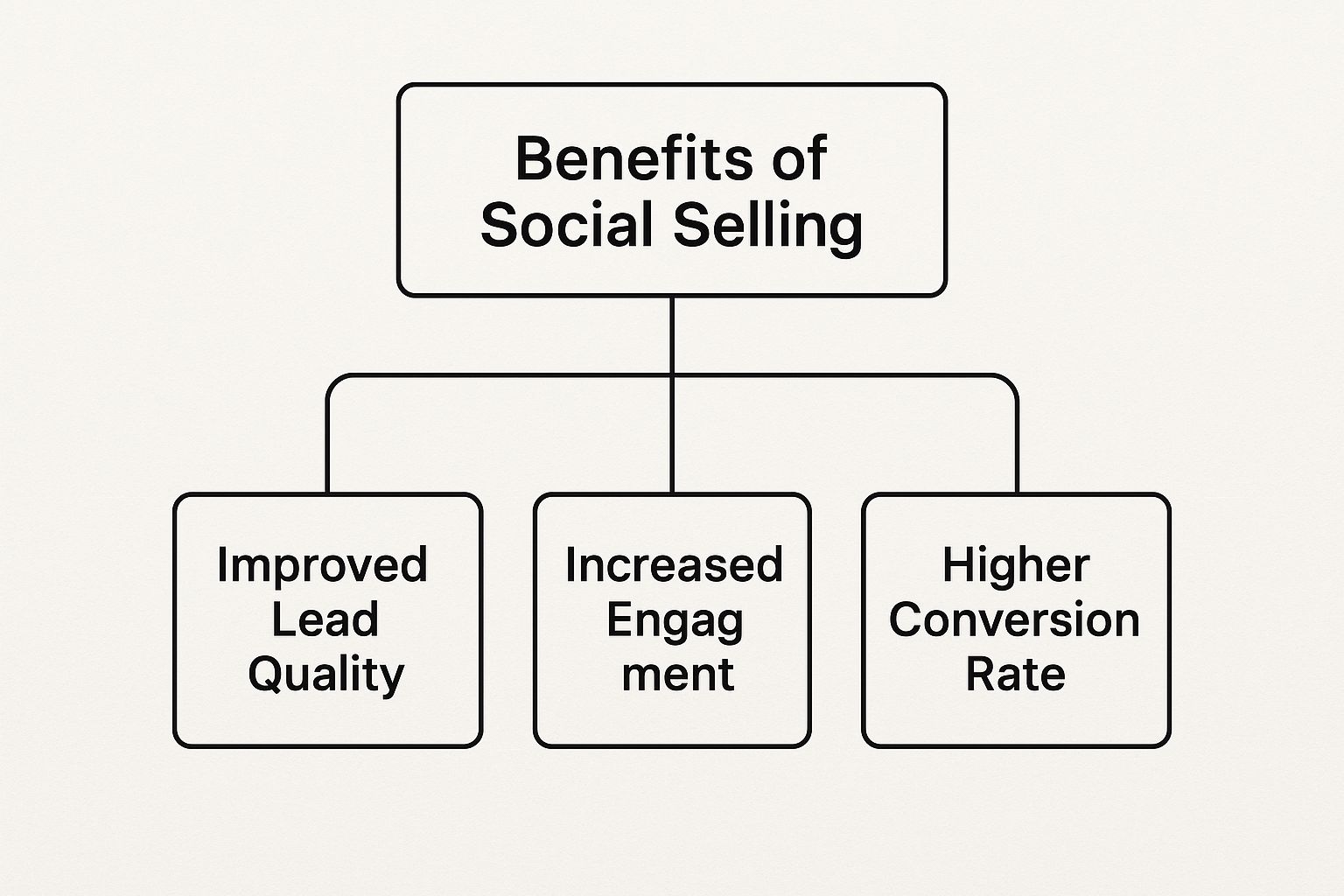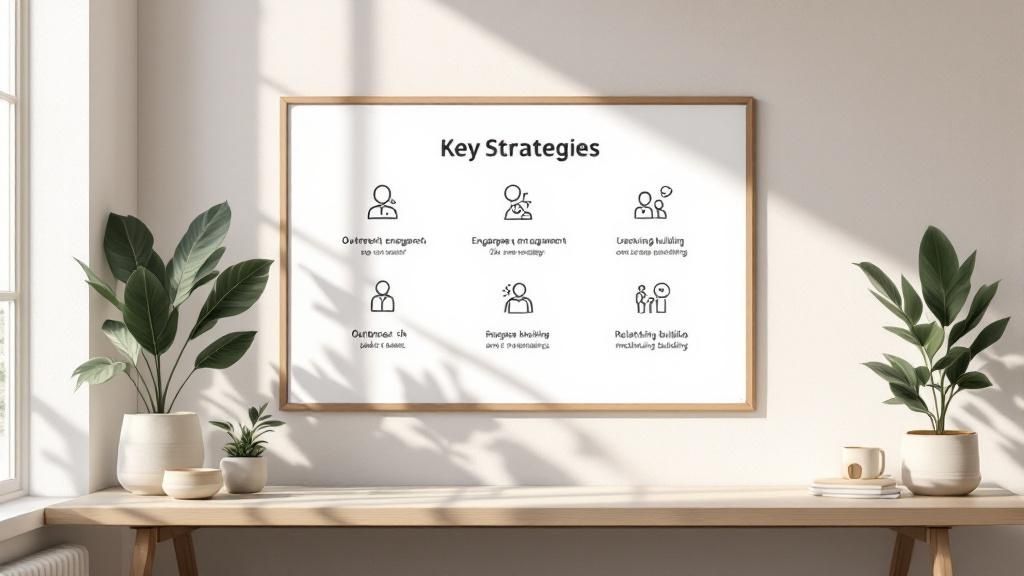So, what exactly is social selling?
It’s the art of using social media platforms—think LinkedIn—to find the right prospects, connect with them in a meaningful way, and build a relationship over time. It’s about establishing yourself as a credible, helpful resource long before you ever think about making a sales pitch.
In short, it flips the old, interruptive sales model on its head.
A Modern Approach to Building Relationships

Let's ditch the outdated image of a salesperson hammering out cold calls from a giant list. Social selling is less like shouting with a megaphone on a busy street and more like being a trusted expert at an industry dinner party. You're there to listen, share insights, and connect—not to push a product on everyone you meet.
The goal here is to shift from a transactional "push" to a relationship-based "pull." Instead of leading with a demo, you lead with value. This could be a helpful article, a thoughtful comment, or a genuine piece of advice.
This approach just makes sense when you consider how people buy today. Modern B2B buyers are incredibly savvy. In fact, 94% of them do their homework online before ever speaking to a salesperson. They’re already on social media, vetting solutions and looking for experts they can trust.
To see just how different this is, let's put the two approaches side-by-side.
Traditional Selling vs Social Selling At a Glance
This table breaks down the core differences between the old way of doing things and the social selling approach. It's a fundamental shift in mindset, from broadcasting to conversing.
| Aspect | Traditional Selling | Social Selling |
|---|---|---|
| Primary Goal | Close the deal quickly | Build long-term relationships |
| Communication | One-way broadcast (pitching) | Two-way dialogue (conversing) |
| Focus | Product features and price | Prospect's needs and pain points |
| Timing | Interruptive (cold calls/emails) | Timely (engaging when relevant) |
| Key Metric | Number of calls/emails sent | Quality of connections and engagement |
As you can see, the entire philosophy is different. One is a numbers game; the other is a people game.
The Fundamental Shift in Sales
So, what does this look like in practice? Social selling really boils down to a few core principles that set it apart from old-school tactics:
- Value First, Pitch Later: Your main job is to offer help and share your expertise. The sale is a natural byproduct of that trust.
- Listening Over Talking: It's about tuning into conversations to truly understand what your prospects are struggling with.
- Building Trust at Scale: You’re not just one person; you’re a credible, go-to resource within your professional network.
- Authentic Engagement: This means real conversations, not generic, copy-paste messages blasted out to hundreds of people.
This strategy is about playing the long game. By consistently showing up as a helpful advisor, you ensure that when your prospects are ready to buy, you are the first person they think of.
This idea of dialogue-driven interaction is central to building modern relationships. To dig a little deeper, it helps to understand what is conversational marketing and how it all connects. When you build a foundation of trust first, the entire sales process becomes smoother, more natural, and way more effective.
The Four Pillars of Successful Social Selling
So, you want to get good at social selling? It's not about firing off random DMs and hoping something sticks. Real success comes from a structured approach, built on four core pillars. Get these right, and you'll turn your social media presence from a static profile into a powerful sales engine.
Think of it like building a house. You wouldn't just start throwing up walls, right? You need a solid foundation. These pillars are that foundation. When they all work together, they create a sturdy framework for predictable growth.
Establish a Professional Brand
First things first: your social media profile isn't just a digital resume anymore. It's your personal storefront, especially on platforms like LinkedIn. This is all about tweaking your profile to speak directly to your ideal customer.
It means ditching a boring headline like "Sales Manager at Company X" for a value proposition like "Helping SaaS companies slash churn with data-driven insights."
This pillar is all about:
- Customer-Centricity: Making sure every single part of your profile answers your prospect's unspoken question: "What's in it for me?"
- Credibility: Using recommendations, relevant content, and your professional background to build immediate trust.
Pinpoint and Connect with the Right Prospects
Once your storefront is looking sharp, it's time to get the right people to walk through the door. This pillar is about finding the right people. Forget generic lists. Dive into the powerful search and filtering tools on social platforms to identify the actual decision-makers who fit your ideal customer profile.
By focusing on quality over quantity, you can build a network of relevant contacts who are genuinely interested in your industry and expertise. This targeted approach is the first step toward creating meaningful sales conversations.
The infographic below really drives home the benefits of adopting this kind of targeted, value-driven strategy.

As you can see, a focused social selling game plan leads directly to better lead quality, which is what really boosts your engagement and, ultimately, your conversion rates.
Engage with Insights and Build Relationships
The last two pillars are where the magic really happens, and they work hand-in-hand. Engaging with insights means you're not just lurking—you're sharing valuable content and jumping into relevant conversations. This isn't about blasting your sales pitch. It’s about offering solutions and becoming a go-to resource in your space.
This is how you build real, trust-based relationships. You consistently add value. The data doesn't lie: 78% of social sellers blow past their peers, drumming up 45% more sales opportunities.
If you're looking for more practical ways to put this into action, check out our guide on effective social selling strategies for B2B sales.
Why Social Selling Is a Non-Negotiable Strategy
Let's be honest, the old playbook for sales is collecting dust. Buyers today are incredibly well-informed, and the classic hard-sell tactics just don’t land like they used to. This is where social selling comes in, and it's not just another buzzword—it's a fundamental shift in how we connect with modern customers.
It’s all about meeting them where they already spend their time: online. Think of it as building trust and rapport before you ever have that first official sales conversation.
By actually engaging on social platforms, sales teams get an unbelievable window into a prospect's real-world challenges and needs. This intel is gold. It lets you craft hyper-personalized outreach that cuts right through the noise of generic cold emails and canned call scripts, teeing up much higher-quality conversations from the get-go.

Driving Measurable Revenue Growth
The business impact here isn't just theoretical; it's tangible and measurable. This approach directly moves the needle on key metrics by shortening sales cycles and forging deeper customer relationships that lead to long-term loyalty.
When salespeople position themselves as genuinely helpful experts, something powerful happens: they start attracting inbound interest instead of constantly chasing down leads.
The most competitive sales organizations don't see social selling as a "nice-to-have." They see it as an essential driver of predictable revenue. It transforms the sales process from a high-volume guessing game into a targeted, relationship-driven engine for growth.
The numbers back this up. Organizations that actively embrace social selling report nearly 60% higher revenue growth compared to those that don't. Even more impressive, leads generated through social media convert at a rate 100% higher than those from old-school outbound methods. That effectively doubles the efficiency of your sales funnel. You can discover more insights on the impact of social selling on Salesgenie.com.
The Key Business Benefits
Adopting a social selling mindset delivers some serious advantages that go way beyond just filling the pipeline. The benefits create a ripple effect across the entire sales organization.
- Improved Lead Quality: You're connecting with prospects who are already engaged and have shown a clear interest in your industry. This naturally leads to far more productive conversations.
- Enhanced Customer Loyalty: When you build relationships on a foundation of trust and value, you create stickier customers. They start to see you as a long-term partner, not just a vendor.
- Greater Market Insight: Consistently monitoring social channels gives you real-time feedback on industry trends, competitor moves, and what customers are really thinking. This is a massive competitive advantage.
Common Mistakes That Sabotage Social Selling Efforts
Diving into social selling without a clear game plan is a recipe for frustration. A lot of well-meaning salespeople make some pretty common mistakes that can hurt their reputation and kill their momentum before they even get started.
The good news? Spotting these pitfalls is the first step toward sidestepping them entirely.
One of the biggest blunders is coming on way too strong with the sales pitch. Imagine you meet someone at a networking event, and before you even shake hands, they’re shoving a product brochure in your face. That’s exactly what a hard pitch in a first message feels like—it’s an instant turn-off and a surefire way to get ignored.
Another classic error is blasting out generic, copy-paste connection requests. These messages scream "I'm just trying to boost my connection count," not "I want to build a real relationship." If you want to focus your energy on the right people, our guide on how to prioritize sales leads is a great place to start.
The Training Gap Problem
So why are these mistakes so common? A huge part of the problem is a lack of proper training. Social selling is a critical skill, but it’s rarely taught formally.
In fact, a staggering 93% of sales executives say they’ve never had any formal training on social selling techniques. It’s no wonder so many fall back on old-school, interruptive tactics that just don't work here. Learn more about the research into social selling statistics at Breakcold.com.
At its heart, effective social selling is about shifting your mindset from "What can I sell?" to "How can I help?" This simple change transforms your entire approach from transactional to relational, which is the real key to long-term success.
Quick Fixes for Common Goofs
Instead of getting caught in these traps, you can make a few small but powerful adjustments to your approach. These simple shifts can make a world of difference.
- Don't: Launch into your product pitch in the very first message.
- Instead: Kick things off with a real conversation. Mention a shared connection, comment on a recent post they shared, or bring up a common industry challenge.
- Don't: Let your professional profile gather dust.
- Instead: Tune up your headline and summary so they speak directly to the problems and goals of your ideal customer. Think of it as your digital storefront.
How to Put Your Social Selling on Autopilot

Let's be honest. Manually managing every part of social selling—from digging for prospects to writing personalized connection requests—is a massive time sink. Authenticity is everything, but the repetitive grind can quickly become a bottleneck, capping your ability to grow. This is where automation tools completely change the game.
Modern platforms are built to do the heavy lifting for you, acting like a digital assistant. They can sift through thousands of LinkedIn profiles to pinpoint prospects who fit your ideal customer profile, saving you countless hours of mind-numbing searches. This frees you up to focus your energy where it actually counts: building real relationships.
The goal isn't to replace the human touch; it's to amplify it. By automating those top-of-funnel tasks, you carve out precious time for the meaningful conversations that happen with warm, interested leads.
Streamlining Your Outreach
Tools like Salesloop.io take this a huge step further by automating entire outreach campaigns. You can set up a multi-step sequence that sends personalized connection requests and follow-up messages over a specific timeframe. It's a simple way to ensure consistent engagement without having to manually track every single interaction.
For small businesses, this kind of efficiency is non-negotiable. To see exactly how you can put this into practice, check out our guide on LinkedIn automation for small businesses for a practical walkthrough.
The core idea is simple: automate the process, not the relationship. You create a predictable system for making that first contact, which in turn generates a steady flow of inbound conversations for you to nurture personally.
This dashboard gives you a glimpse of how you can manage multiple campaigns and track your most important metrics all in one place.

This kind of centralized view allows a single sales pro to effectively manage the kind of outreach that would normally take a small team to pull off. To really push your results to the next level, consider exploring some advanced AI-powered social media engagement strategies to fine-tune your approach even further.
Your Step-By-Step Social Selling Launch Plan
Moving from theory to practice is where the magic happens. Kicking off a social selling strategy doesn't mean you have to flip your whole sales process upside down. All it takes is a clear, manageable plan.
This five-step roadmap is designed to get you started right now, building momentum with simple actions you can repeat daily. Each step builds on the last, creating a solid foundation that will pay off for years to come.
Step 1: Give Your Social Profiles a Makeover
Your social media profile is your new storefront. First things first: stop treating it like a resume and start treating it like a resource for your ideal customer.
Your LinkedIn headline is the perfect place to start. Instead of a generic job title like "Account Executive at Tech Corp," switch it to a clear value proposition. Try something like, "Helping B2B companies reduce operational costs with automation." Right away, prospects know exactly how you can help them, turning your profile into a magnet for the right people.
Step 2: Find Your People
Next up, it’s time to use the powerful search tools on platforms like LinkedIn to build laser-focused prospect lists. Forget casting a wide net. You need to define your ideal customer with precision—think industry, company size, and specific job titles.
This focus makes sure all your effort is spent on people who can actually see value in what you're offering.
Step 3: Get Into a Content Rhythm
You don't need to become a full-time content creator overnight. Just get into a simple rhythm of sharing valuable, relevant content. This could be an insightful article about your industry or a helpful post from your company’s blog.
The goal here is consistency, not volume.
A simple routine of sharing one valuable piece of content each day positions you as a knowledgeable resource. It keeps you visible and builds credibility without demanding hours of your time.
Step 4: Make Engagement a Daily Habit
This one is non-negotiable. Set aside 15-20 minutes every single day to actually interact with your network. I'm talking about genuine, human engagement.
Leave thoughtful comments on posts from your prospects. Jump into relevant group discussions. Congratulate people on their work anniversaries or new roles. It's the small things that build real connections.
Step 5: Scale Smart with Automation
Once you've got the fundamentals down, it's time to work smarter, not harder. Bring in an automation tool like Salesloop.io to handle the repetitive stuff, like sending out those initial connection requests.
This frees you up to scale your outreach without sacrificing the personal touch needed for real relationship-building. Remember, you're automating the process, not the conversation.
Of course, here is the rewritten section, designed to sound like an experienced human expert while following all your specific formatting and style requirements.
Your Social Selling Questions, Answered
Alright, even with the best game plan, you're probably wondering what this looks like in the real world, day in and day out. Let's tackle some of the most common questions I hear from reps just getting started. Think of this as your quick-start guide to building confidence.
Just remember, the real magic happens with consistent, genuine effort. It’s not about random bursts of activity, but about building habits that pay off in the long run.
How Much Time Do I Really Need to Spend on This Each Day?
This is where people get intimidated, but you don't need to spend hours glued to your screen. In fact, that's counterproductive. Consistency will always beat intensity.
I tell my team to aim for a focused 20-30 minutes every single day. That’s it. In that time, you can share one great piece of content, drop meaningful comments on five to ten posts from your target accounts, and send a handful of truly personalized connection requests. The right tools make this window of time incredibly powerful.
Which Social Platform Should I Focus On?
Simple: go where your customers are. While it's tempting to try and be everywhere, you need to focus your energy where it counts.
For most B2B sales, LinkedIn is the undisputed king. Its entire ecosystem is built for professional networking and its search tools are second to none. But don't just default to it without thinking.
- Selling B2B Software/Services? LinkedIn is your home base. No question.
- Targeting Creative Professionals? You might find them more active on Instagram or even Pinterest.
- In Fast-Paced Industries like News or Finance? X (formerly Twitter) can be a goldmine for real-time engagement and spotting opportunities as they happen.
Does Social Selling Actually Work for My Industry?
Absolutely. The core idea—building trust and creating value before you ask for anything—is universal. This isn’t some niche tactic for tech startups; it's a fundamental shift in how we communicate with buyers.
I've seen it work wonders in just about every field, from heavy manufacturing and financial services to healthcare and consulting. The tactics might change—a consultant will share different content than someone selling industrial equipment—but the strategy remains the same. The key is simply to adapt your style and your content to what your specific audience cares about.
Ready to stop the manual grind and start scaling your outreach? Salesloop.io automates the tedious parts of social selling so you can focus on what matters—building relationships and closing deals. Start your free trial today and see the difference.





